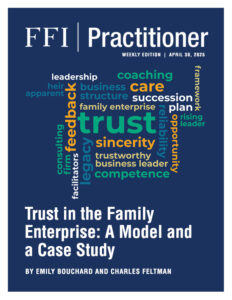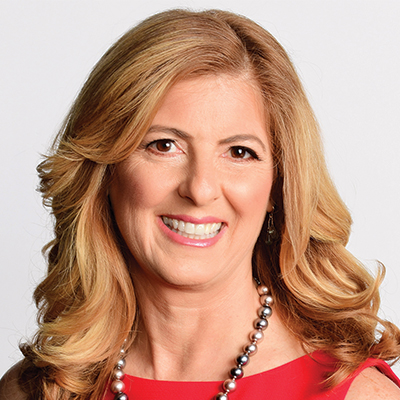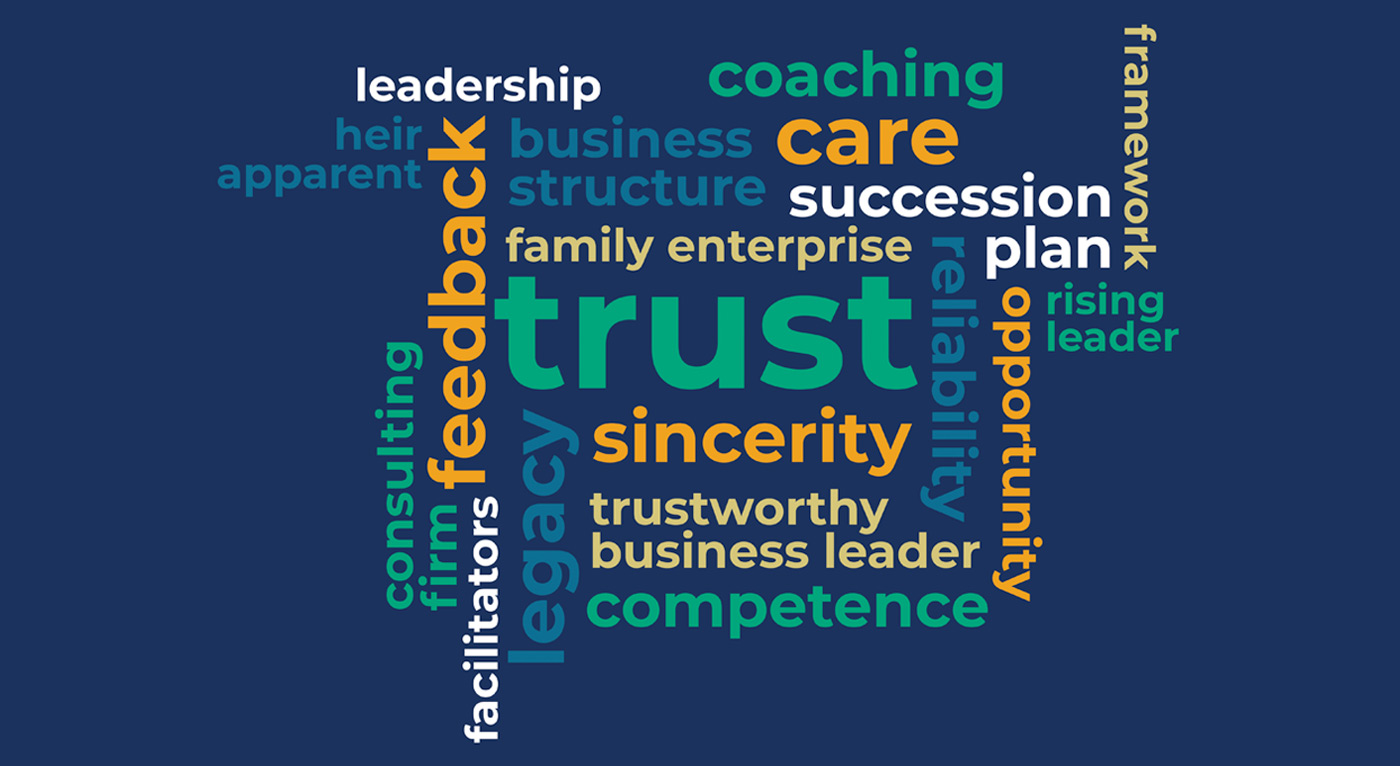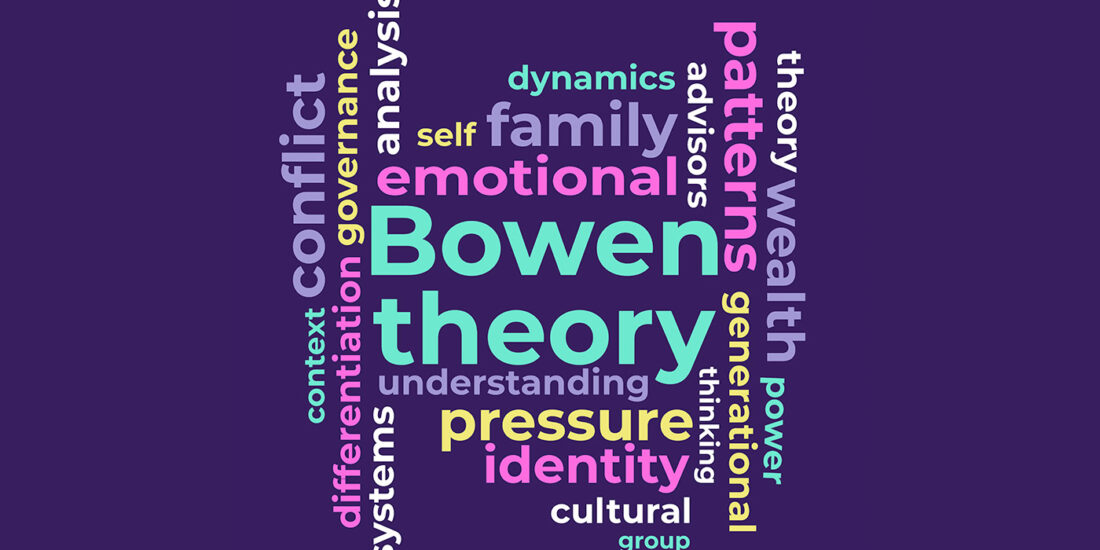
View this edition in our enhanced digital edition format with supporting visual insight and information.
As with the April 16 FFI Practitioner issue, today’s article is a conversation starter in which Emily Bouchard and Charles Feltman use a model and a case to open conversations that can repair conflicts and build trust among client families.
These conversation starters are designed to assist advisors in opening topics that are appropriate to multi-generational companies, such as reflections on the past, looking ahead, personal insights, collaboration models, and more. Please read on for “Trust in the Family Enterprise: A Model and a Case Study.”
The following case illustrates a trust model used to repair trust and empower a rising leader in a family enterprise. As advisors well know, the complex overlapping of family and business systems can have far-reaching implications when there is a breakdown in trust.
Case and Presenting Problem
Rick was in a difficult situation. A key non-family executive had just left Rick’s office after telling him that if his son, Bobby, became president as part of Rick’s succession plan, she would be leaving. She told Rick she did not trust Bobby and would be concerned about the future of the company if he were to be selected as the next leader.
Rick knew there were issues with Bobby’s performance, but he had hoped Bobby’s conduct was not cause for concern. In addition to the non-family executive, Rick’s three daughters frequently complained that Bobby dismissed their opinions, ignored their requests, and usually arrived late for family gatherings. Within the business structure, Bobby and his sisters owned equal shares in the company.
Tensions were heightened as Rick prepared to hand over the reins to Bobby. Rick’s eldest daughter, Cheryl, was particularly concerned, as her husband Tim, a respected manager within the company, frequently heard complaints from disgruntled employees about Bobby’s conduct. Although Tim was not a direct owner, he was deeply committed to the future of the business, both as a way to honor his father-in-law’s legacy and as an opportunity for his children to work in the business in the future.
After hearing these concerns about Bobby, Rick decided to hire a consulting firm to help him address the underlying issues impacting the family’s business transition. During this engagement, the advisor helped the family to identify the lack of trust in Bobby as a key impediment to Rick’s succession plan. The advisors used the following model and framework for addressing issues of trust.
Introductory Meeting and Coaching
After an introductory meeting with Rick and his wife Becky to establish goals for the engagement, the consulting team performed in-depth interviews with each family member, including in-laws, to better understand family dynamics and individual concerns and to develop the family’s trust in the process.
Before convening the rest of the family for a collective meeting, Rick and Bobby both agreed to undergo individual coaching. Bobby, recognizing that his career path and his familial relationships were at stake, was committed to this developmental work to prove he could be a trustworthy business leader and partner to his siblings.
A Trust Framework
At a subsequent family meeting the family worked together to establish a safe environment, drafting ground rules and a “code of conduct.” At this meeting, the family agreed to use a framework based on The Thin Book of Trust, which outlines four elements that people can use to assess each other’s trustworthiness:1
- Sincerity: This person is transparent and honest and acts with integrity when interacting with others. He or she acts in good faith without hidden agendas.
- Reliability: Reliable people consistently deliver on commitments they make to each other and to outside stakeholders. If they cannot deliver as promised, they alert the person with whom they made the commitment as soon as possible and renegotiate as necessary.
- Competence: Each family member has the skills, knowledge, experience, and expertise needed to fulfill defined roles within the family enterprise. Each family member expects the others to acknowledge when they need help and to ask for it.
- Care: Caring family members support each other’s best interests and hold the family’s interests on par with their own. They intend good for each other and assume positive intent. They provide constructive feedback and receive feedback with curiosity. They understand that their family members are in this together.
Family members can use these four elements as a framework to talk about their trust concerns, focusing on the behaviors that need to be addressed, rather than on character issues.
Process for Rebuilding Trust
-
Start with Care
Rick’s family began the work of rebuilding trust by first working together to define shared family values and to identify the positive aspects of their family culture. They also took time to reflect on what they most enjoy about each other and what family means to them. They articulated how they had demonstrated their care for each other and reflected on the behaviors of other family members that conveyed the message “I respect what you care about.”
-
Repair Trust
While the primary purpose of these meetings was to address specific breakdowns in trust with Bobby, the family also explored ways they were each contributing to building or damaging trust with one another. As each family member shared what behaviors impacted their trust in one another, the family discussed where those behaviors demonstrated untrustworthiness within the model of trust by answering exploratory questions:
- Is this behavior an example of insincerity?
- Does this behavior demonstrate a lack of reliability?
- Does this behavior illustrate a need to increase competence?
- How might the identified experience indicate a breakdown in care?
Cheryl started by sharing a behavior that seemed simple: Being on time to family functions. The family agreed that when someone is late once or twice, that’s a reliability issue. When someone is consistently more than thirty minutes late, his or her unreliability starts to generate distrust in this person’s sincerity and may also communicate a lack of respect or care for the rest of the family.
Bobby acknowledged that his consistent tardiness had been disrespectful and admitted that he was lousy at tracking time—and that this chronic lateness was impacting work and family relationships. Family members discussed how he could not use that admission as an excuse and brainstormed creative solutions for being on time. In his coaching sessions, Bobby worked on receiving feedback with gratitude and without defensiveness, which surprised his family and helped him begin re-establishing trust.
Other members of the family also received coaching, since it can be common for family members to see one another only as they have been before and not trust their new behaviors as authentic.
-
Practice Feedback
The facilitators asked the family to consider how they give feedback. This family, like many others, used sarcasm and complaining, but no one could recall providing direct feedback to Bobby about his previous behavior.
After identifying that the family was concerned about giving direct feedback to Bobby for fear of hurting his feelings or starting an argument, the facilitators taught them new feedback techniques. Bobby, who had been coached in advance by the consultants, demonstrated how he learned to regulate his emotions, decreasing the likelihood of becoming upset or defensive.
The family then explored giving and receiving honest feedback in a structured format. They were invited to pay attention to their feelings when both giving feedback and when receiving it, applying the techniques that the advisors had presented. They agreed to practice communicating about trust between quarterly family meetings, naming which of the four elements were at risk. At first, the practice seemed formulaic, but they used good-natured humor to break tension and allow for missteps.
Key Results
As Bobby’s interactions with family members and company employees continued to improve, he began receiving positive feedback. Nonetheless, when he discussed the results of these changes with Rick, he revealed that he did not feel ready to lead the company. Bobby decided to enroll in a NextGen leadership program to gain more skills, get feedback from peers, and build his competence. He realized that what others were experiencing as arrogance or lack of respect most likely originated from his insecurity about the pressure and responsibility he felt as the “heir apparent.”
Bobby and his brother-in-law Tim became trusted allies, enabling Tim to provide Bobby with constructive feedback. Rick later designed leadership roles for both Tim and Bobby, designating them to co-lead corporate training on the elements of trust.
Conclusion
By having a clear and relatable framework for discussing trust, families can repair breakdowns and build skills to maintain and deepen trust within the family system as well as among employees and other stakeholders.
Trust is an option, a choice. It is an active part of our daily lives, and developing trust requires specific skills and commitment that extend beyond a mutual understanding or good luck.
—Fernando Flores and Robert C. Solomon, Building Trust: In Business, Politics, Relationships, and Life
Reference
1 Charles Feltman, The Thin Book of Trust: An Essential Primer for Building Trust at Work, 3rd ed. (Berrett-Koehler Publishers, 2024).
About the Contributors

Emily Bouchard has twenty years of experience as a chief learning officer and family advisor, specializing in stepfamily dynamics, rising generation leadership, and family business succession. She is the co-author of Estate Planning for the Blended Family and Beginners Guide to Purposeful Prenups. https://emilybouchard.com

Charles Feltman serves people who seek to become leaders in their professional fields. For more than twenty-five years, he has served as an executive coach worldwide. Feltman is the author of The Thin Book of Trust: An Essential Primer for Building Trust at Work. He can be reached at charles@insightcoaching.com.

View this edition in our enhanced digital edition format with supporting visual insight and information.





